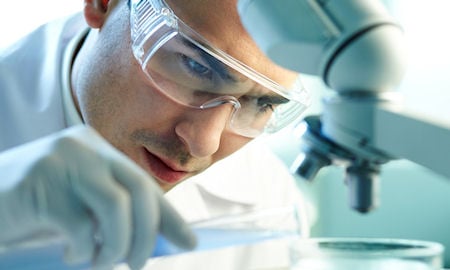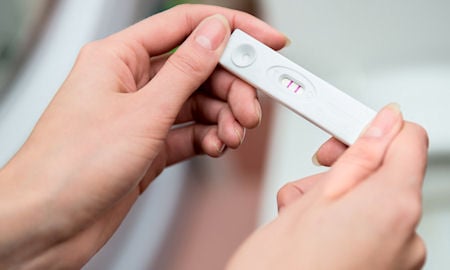ART procedures
Advances in microscopic equipment and knowledge about eggs, sperm, and embryos have led to the development of new techniques in assisted reproductive technologies (ART). Micromanipulation refers to the microscopic treatment of individual eggs, sperm, or embryos in an effort to improve fertilization and/or pregnancy rates. These techniques require specialized equipment and personnel. Each clinic may have different instructions for patients using these techniques that should be followed to help maximize success.
Intracytoplasmic Sperm Injection (ICSI)
The ICSI technique has been developed to treat cases of severe male factor infertility. The procedure achieves fertilization by injecting a single sperm into the cytoplasm (interior) of the egg. Mature eggs are freed of surrounding cells by a combination of enzyme treatment and microdissection. Using special micromanipulation equipment, the eggs are individually injected with a single sperm. Injected eggs are returned to the laboratory incubator and treated as in conventional IVF.
The benefit of ICSI is that it treats severe male factor infertility. Experience shows that fertilization in vitro requires a minimum number of motile, normal-shaped sperm. The chance for fertilization with conventional insemination may be very low when this minimum number of sperm is not available. Theoretically, only a few sperm are necessary to perform ICSI.
The incidence of congenital abnormalities (birth defects) following ICSI appears to be slightly higher than that of the general ART population. This observation is based on the experience of several thousand babies born worldwide following ICSI. There has been some evidence that ICSI may increase the probability of abnormal sex chromosomes or imprinting disorders. Larger studies though do not support these conclusions. However, this issue is an area of ongoing investigation and it must be recognized that long-term risks of the procedure (for example, regarding the child’s fertility) are unknown. Recent evidence suggests that some forms of severe male factor infertility are genetic and may be passed on to male offspring through the ICSI procedure.
Assisted Hatching
Embryos are often transferred to the uterus three to six days after retrieval. Assisted hatching is used on day 3 embryos, which may consist of six to eight cells. After the transfer of a day 3 embryo, the embryo must continue to develop to the blastocyst stage before implantation can occur. This development takes several days. Immediately before implantation, the blastocyst must "'hatch" from the zona coating that originally enveloped the egg. To assist the hatching process, a hole is made into the covering (zona pellucida) that surrounds the developing embryos. This involves dissolving part of the zona coating with an acid solution or cutting it with a laser. Trained personnel, using specialized micromanipulation tools, must perform this under the microscope. There is a small risk of damage to the embryos or having identical twins.
PGT (Preimplantation Genetic Testing and Embryo Biopsy)
Preimplantation Genetic Testing (PGT) can be used during IVF procedures to test embryos for genetic disorders prior to their transfer to the uterus. Preimplantation genetic testing, allows patients to test embryos for several types of genetic issues. Most commonly, it is used to make sure the embryo has the correct number of chromosomes. This is called PGT for aneuploidy or PGTA. Another type of PGT is PGTM or preimplantation genetic testing for monogenic or single-gene disorders. This may help patients reduce the risk of having a child with a specific heritable medical condition, avoiding a sex-linked genetic condition, or having a child that is an HLA-type match for a sibling needing stem cell therapy. Some patients use PGT for structural rearrangements, or PGT-SR, to avoid pregnancy loss if the patient or partner has a balanced translocation.
These techniques involve using a micromanipulator to biopsy or remove cells from an embryo. The cells are then sent to a diagnostic lab. Acceptable embryos can then be transferred to the patient, potentially decreasing the odds of having an affected child.
Freezing of Embryos and Eggs and Frozen Embryo Transfer
Embryo and egg freezing freezing is an important part of ART programs. Freezing allows patients several advantages. Patients can freeze embryos in excess of the ones that are transferred during an IVF cycle. These embryos provide a second or even third opportunity for pregnancy without undergoing another ovarian stimulation and retrieval. Freezing can also increase the safety of an IVF cycle and help decrease the probability of multiples, as fewer embryos can be transferred in the fresh cycle when frozen embryos can be relied upon for subsequent pregnancy attempts. Currently, most embryos are frozen at the blastocyst stage (day 5-7 after fertilization). Sometimes embryos can be frozen 1 or 3 days after fertilization. Embryos have to meet developmental and quality criteria to be frozen.
Egg freezing is a more recent technology. Some patients may choose to freeze eggs for medical reasons in which the treatment may affect their ovarian reserve or fertility, such as a recent cancer diagnosis, medical therapy, or planned surgery. Due to age-related fertility decline, some patients will freeze their eggs if they are not yet ready to have a child.
The most common method of freezing is called vitrification. It allows embryos and eggs to be frozen and thawed very quickly. Compared to prior methods of slow freezing, it has allowed better pregnancy rates. Frozen embryos and eggs are then stored in liquid nitrogen (at -196°C or approximately -400°F) or, sometimes, in liquid nitrogen vapor. Not all embryos and eggs survive the freezing/thawing procedure. Embryos and eggs can be stored for years in liquid nitrogen without a loss of viability.
Donor Eggs
One of the most important factors in predicting the success of IVF is the age of the person providing the egg. Eggs from younger women have greater fertility potential, and this potential is utilized in donor egg treatment. In this situation, eggs from another woman (the donor) are fertilized with the intended parent’s or donor's sperm, and the resultant embryos are placed in the intended parent’s or a gestational carrier’s uterus.
Follicles are stimulated and eggs are retrieved from the donor using routine IVF techniques. Also, patients can use frozen donor eggs from an egg bank. The donor may be known to the recipient (directed donation), or instead may be unknown to the recipient (non-identified or traditional)). Non-identified, traditional egg donation usually occurs when a young woman donates her eggs to a recipient(s) during a particular cycle. The egg donor is often reimbursed for her time and effort. Pregnancy rates using young donors are significantly higher compared to those achieved in women of similar age using their own eggs.
Candidates for Donor Egg
There are several indications for donor eggs:
- Ovarian failure. This can be due to a wide variety of different causes, including radiation, chemotherapy, surgical removal of the ovaries, and a variety of disease states that cause or are associated with ovarian failure
- Women who carry a serious genetic disease who wish to diminish the chance that the disease will be passed on to their offspring
- Women whose age is sufficiently advanced so that their fertility potential is impaired significantly
- Women who have had poor-quality embryos during prior IVF cycles.
- Laboratory Testing, Genetic Screening, and Psychological Assessment
A short time before initiating a treatment cycle, the egg donor undergoes several tests for sexually transmitted infections. Donors are screened for sexually transmitted infections to minimize the chances that an infection will be passed from the donor to the recipient. All donors must meet strict FDA criteria. This includes tests for infectious diseases, disease screening through a questionnaire, and a physical exam.
Donors have a very thorough evaluation of their medical, psychological, and family history. The donor is required to fill out a multi-page form detailing her family history and have genetic carrier screening. The IVF personnel review this form and other aspects of the donor’s genetic and medical history prior to acceptance of the donor into the program. Even with this intensive screening, there remains a small risk that a pregnancy resulting from the egg donation process will inherit a genetic disease. Overall, a child conceived through egg donation will have the same risk of birth defect, genetic or non-genetic, as the general population, approximately 3-5 percent. The donor and recipient also receive psychological screening and counseling with a mental health professional to assess their motivations and acceptance of the process. This evaluation serves as an additional opportunity to learn about family and medical history and discuss how to tell the child how they were conceived.
Matching Donor and Recipient
One requirement of most anonymous donation programs is that anonymity be maintained. To accomplish this, the amount of information given to a recipient about the donor is limited. This information usually includes the donor’s height and weight, hair color, eye color, race, blood type, age, duration of formal education, and family medical history.
Treatment of the Egg Donor
In general, stimulation of the egg donor’s cycle is similar to that of a woman using her own eggs for IVF transfer. A GnRH antagonist may be given after stimulation has begun to prevent ovulation. After the donor’s period has started, daily injections of gonadotropins, such as FSH and HMG. Various brands of these hormones can be used. Generally, the donor will receive daily gonadotropin injections for a total of 7 to 12 days. During the time that the donor is receiving the gonadotropin injections, she will have frequent vaginal ultrasound examinations and blood drawing for determination of estradiol level. When ultrasound and blood testing indicate that the development of the follicles (follicles are the ovarian structures that contain the eggs) is optimal, the donor receives an injection of a different pharmaceutical medication called GnRH or human chorionic gonadotropin (hCG). Two days after GnRH or hCG injection, egg retrieval is performed.
Treatment Regimen for Recipients
The recipient’s cycle may be manipulated to synchronize her with the donor. A combination of two or three hormonal medications is used to modify the recipient’s cycle. It is also common for the embryos to be frozen during the donor IVF cycle and the recipient and/or gestational carrier undergo a frozen embryo transfer.
To synchronize with the donor, the recipient of the embryo will be given a medication that suppresses their own cycle. Sometimes oral contraceptives will be used. A short time after her period starts, the recipient will begin taking estrogen. Estrogen comes in several forms including patches, oral tablets, and vaginal suppositories. The recipient will take estrogen while waiting for the donor’s cycle to come into synchrony with hers. When the donor’s cycle has “caught up” with the recipient’s, a simulated (artificial) menstrual cycle will be created in the recipient with the hormonal medications. Then, the recipient takes an increased dose of estrogen as the donor stimulates. Sometimes blood tests and/or ultrasounds are done to ensure an appropriate response. Around the time of the egg retrieval, progesterone treatment is begun. Daily progesterone can be in the form of an intramuscular injection or vaginal administration. Fresh embryo transfer is usually done 5 days after egg retrieval. A blood pregnancy test will be performed 9-10 days after embryo transfer. If the recipient is pregnant, estrogen and progesterone treatment may be continued through about the 10th week of pregnancy.
Gestational Carriers
In some instances, a couple may require the assistance of a gestational carrier to achieve a successful pregnancy. Gestational carriers differ from true surrogates in that they have no genetic link to the baby they will carry. The intended parents (future parents) will provide the embryo through IVF. Some states have laws that address gestational carriers. The most common indications include a woman who has congenital absence of the uterus, prior surgery to remove her uterus, severe scarring of the uterine cavity, or a medical history that precludes pregnancy. In addition to meeting the medical requirement, a separate legal contract is required before treatment can begin. Once a gestational carrier has been identified and the medical, psychological, and legal prerequisites completed, treatment can proceed. Because gestational carriers will receive an embryo from a donor couple, the people who provide the eggs and sperm must be treated as egg and sperm donors and follow all of the requirements of the FDA for screening and testing as indicated by the FDA.



